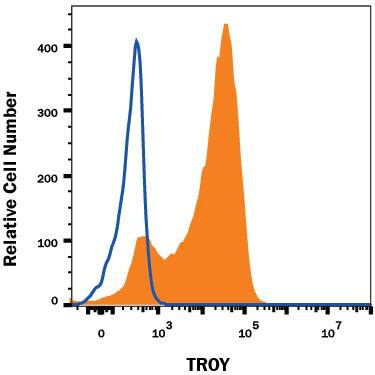Human TROY/TNFRSF19 Antibody
R&D Systems, part of Bio-Techne | Catalog # MAB15481


Key Product Details
Species Reactivity
Applications
Label
Antibody Source
Product Specifications
Immunogen
Glu30-Leu170
Accession # Q9NS68
Specificity
Clonality
Host
Isotype
Scientific Data Images for Human TROY/TNFRSF19 Antibody
Detection of TROY/TNFRSF19 in HEK293 Human Cell Line Transfected with Human TROY/TNFRSF19 by Flow Cytometry.
HEK293 human embryonic kidney cell line transfected with either human TROY/TNFRSF19 (filled histogram) or irrelevant transfectants (open histogram) was stained with Mouse Anti-Human TROY/ TNFRSF19 Monoclonal Antibody (Catalog # MAB15481), followed by Allophycocyanin-conjugated Anti-Mouse IgG Secondary Antibody (Catalog # F0101B). View our protocol for Staining Membrane-associated Proteins.Applications for Human TROY/TNFRSF19 Antibody
CyTOF-ready
Flow Cytometry
Sample: HEK293 human embryonic kidney cell line transfected with human TROY/TNFRSF19
Formulation, Preparation, and Storage
Purification
Reconstitution
Formulation
Shipping
Stability & Storage
- 12 months from date of receipt, -20 to -70 °C as supplied.
- 1 month, 2 to 8 °C under sterile conditions after reconstitution.
- 6 months, -20 to -70 °C under sterile conditions after reconstitution.
Background: TROY/TNFRSF19
TROY (also known as TAJ and TNFRSF19) is a 45‑55 kDa member of the TNF receptor superfamily of molecules (1‑4). It is widely expressed in the embryo, but shows limited expression in adult. In particular, embryonic
References
-
Hu, S. et al. (1999) Genomics 62:103.
-
Eby, M.T. et al. (2000) J. Biol. Chem. 275:15336.
-
Kojima, T. et al. (2000) J. Biol. Chem. 275:20742.
-
Hashimoto, T. et al. (2008) Cell Cycle 7:106.
-
Pispa, J. et al. (2003) Gene Exp. Patterns 3:675.
-
Mi, S. (2008) Cytokine Growth Factor Rev. 19:245.
-
Satoh, J. et al. (2007) Neuropathol. Appl. Neurobiol. 33:99.
-
Shao, Z. et al. (2005) Neuron 45:353.
-
Park, J.B. et al. (2000) Neuron 45:345.
-
Spanjaard, R.A. et al. (2007) Int. J. Cancer 120:1304.
-
Venkatesh, K. et al. (2007) J. Cell Biol. 177:393.
- Pispa, J. et al. (2008) Hum. Mol. Genet. 17:3380.
Long Name
Alternate Names
Gene Symbol
UniProt
Additional TROY/TNFRSF19 Products
Product Documents for Human TROY/TNFRSF19 Antibody
Product Specific Notices for Human TROY/TNFRSF19 Antibody
For research use only